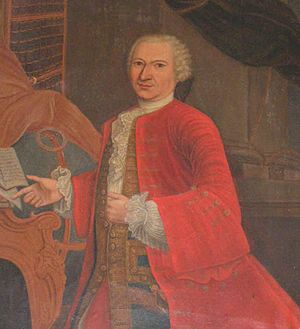Charles-Henri-Louis d'Arsac de Ternay facts for kids
Quick facts for kids
Charles-Henri-Louis d'Arsac, chevalier de Ternay
|
|
|---|---|
 |
|
| Born | 27 January 1723 Angers, France |
| Died | 15 December 1780 (aged 57) Duc de Bourgogne, Newport, Rhode Island |
| Buried |
Trinity Churchyard, Newport, Rhode Island
|
| Allegiance | |
| Service/ |
|
| Years of service | 1738-1780 |
| Rank | Rear Admiral |
| Unit | Expédition Particulière |
| Battles/wars | Seven Years' War American Revolutionary War |
Charles-Henri-Louis d'Arsac, chevalier de Ternay (born January 27, 1723 – died December 15, 1780) was an important French naval officer. He played a key role in the Seven Years' War and the American Revolutionary War. In 1762, Ternay led a successful mission to capture St. John's in Newfoundland. Later, in 1780, he became the naval commander for a special project called the Expédition Particulière. This mission brought French troops to America to help in the War of American Independence. He passed away in Newport, Rhode Island, at Hunter House, which was the main base for the French fleet.
Contents
Charles-Henri-Louis d'Arsac de Ternay was born on January 27, 1723, likely in Angers, France. When he was about 14 years old, in 1737, he began serving as a page for the Knights of Malta. The very next year, in 1738, he joined the French Navy. He worked his way up through the ranks. By January 10, 1761, he received his first command, leading a ship called the Robuste.
Fighting in the Seven Years' War
In 1762, near the end of the Seven Years' War, Ternay was chosen for a secret mission. His goal was to attack and take control of the British-held island of Newfoundland. He was also told to possibly attack Fortress Louisbourg, which was also controlled by the British at the time.
The Secret Mission to Newfoundland
On May 20, 1762, Ternay led a small fleet of ships from Brest. They managed to get past the British ships blocking the French coast. His fleet included two large warships, one smaller frigate, and two supply ships called flutes.
They arrived at Bay Bulls on June 20. Ternay landed 750 soldiers, who were led by Joseph-Louis-Bernard de Cléron d'Haussonville. These soldiers quickly captured St. John's without any fighting, as the British soldiers there were few. After taking St. John's, Ternay made sure that the fishing areas and fishing boats were destroyed. The British estimated that this caused about £1 million in damage.
British Response and Ternay's Escape
The French did not expect the British to react until the next year. However, General Sir Jeffery Amherst learned about the French attack in July. He quickly put together a group of ships and soldiers to take Newfoundland back.
The British fleet arrived on September 12, landing 1,500 troops the next day at Torbay. Two days later, after the Battle of Signal Hill, the French troops had to retreat into Fort William. Ternay suggested leaving the fort, but the other officers decided to leave the soldiers and some marines behind. They planned for the fleet to pick them up later.
However, with good wind and foggy weather, Ternay made a quick decision. He chose to leave that very night, slipping away with his ships. This left the French soldiers behind, and they surrendered three days later. Ternay's journey back to France was tough. He had to escape from British ships and found safety in the Spanish port of Corunna. He finally reached Brest in January 1763. Even though some criticized him for leaving the soldiers, Ternay was praised for saving his fleet.
Role in the American Revolutionary War
After the Seven Years' War, Ternay continued to command ships. In 1771, he was promoted to brigadier general. At the same time, he became the governor-general of Isle de France (now Mauritius) and Île-Bourbon (which is now Réunion). In November 1776, he was promoted again, becoming a rear admiral.
Leading the French Fleet to America
In 1780, Ternay was given command of the naval forces for the Expédition Particulière. This important mission was to carry the French army, led by the Comte de Rochambeau, to Newport, Rhode Island. Their goal was to help the Continental Army in the American Revolutionary War.
On May 2, 1780, Ternay left Brest with a squadron of seven warships and three frigates. They escorted 36 transport ships that were carrying troops. The main ship was the 80-gun Duc de Bourgogne, which Ternay commanded. Other ships included the 74-gun Neptune and Conquérant, and the 64-gun Provence, Ardent, Jason, and Éveillé. The frigates were Surveillante, Amazone, and Bellone. The Amazone, which was at the front of the fleet, arrived in Boston on June 11, 1780.
His Final Days
After Ternay's fleet arrived in America, the British ships blockaded them. Ternay became ill with typhus and passed away on December 15, 1780. He died at Hunter House in Newport, which was the French headquarters. After his death, Sochet Des Touches took over command of the expedition.
Ternay never married or had children. He was buried in the churchyard of Trinity Church in Newport. Both King Louis XVI of France and the United States Congress placed memorials there to honor him. After his death, he was also recognized by the Society of the Cincinnati for his service in the war.
Places around the world are named after him. In the Port Glaud district of Mahé, Seychelles, there is a bay called Baie Ternay and a cape called Cap Ternay. There is also a bay called Ternay in Primorsky Krai, Russia. This bay was discovered by La Pérouse on June 23, 1787, and named after Ternay. A settlement with a similar name, Terney, also exists near that bay.
Images for kids
See also
 In Spanish: Charles-Henri-Louis d'Arsac de Ternay para niños
In Spanish: Charles-Henri-Louis d'Arsac de Ternay para niños


